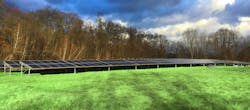Schneider and Citizens Energy activate unique renewable microgrid on Connecticut campus
Schneider Electric and Citizens Energy have activated the first microgrid in Connecticut that can run on 100% renewable energy around the clock while in island mode. The project is located at the Daughters of Mary of the Immaculate Conception campus.
The $7 million project, first described by Microgrid Knowledge in April 2021, evolved into a microgrid that will power four stand-alone buildings and reduce energy costs for the organization, which provides social services and senior care. The microgrid will employ 1.4 MWh of battery storage and 1.2 MW of solar generation, with a 250-kW natural gas generator available for emergency use.
The project is unusual in that it is essentially four individual microgrids engineered to allow each to remain grid-tied, island independently or share electrons and island together as one larger microgrid.
“We are so proud to celebrate this massive feat for renewables today,” said former US Rep. Joseph P. Kennedy III, now managing director at Citizens Energy. “My father founded this company to be a change maker. Not only are we fulfilling our mission to make life’s basic needs more affordable, but we are building the clean energy projects that others only talk about. This may be the first of its kind, but it won’t be the last!”
The Connecticut Department of Energy and Environmental Protection (DEEP) granted $3.9 million for the microgrid.
“This advanced microgrid is the first in Connecticut to combine solar panels and battery storage to provide an extra layer of resilience for up to 19 days of continuous power to ensure that the important care and services the Daughters of Mary provide can continue during a power outage,” said DEEP Commissioner Katie Dyke.
Located in New Britain, the project was developed through the Connecticut Green Bank’s Commercial Property Assessed Clean Energy program, a green bank that allows facilities to pay over time through an assessment on their property tax bills.
“This project exemplifies the green bank’s vision for a ‘planet protected by the love of humanity,’ as the energy savings from this system allow the Daughters to enhance their mission of caring for those in need,” said Bryan Garcia, president and CEO of the Connecticut Green Bank.
The microgrid project was named in honor of the late Mother Mary Jennifer Carroll, who was instrumental in the installation of a solar array on the campus five years ago. The array has been incorporated into the microgrid.
“On behalf of the full team at Schneider Electric, we’re honored to have been selected as a trusted alliance partner to make this incredibly dynamic project come to life,” said Don Wingate, vice president of microgrids at Schneider Electric. “We’re thrilled to bear witness to the positive impact of this one-of-a-kind microgrid on the critical care facilities that support families in crisis as it reduces the energy costs for the entire campus community.”
Two local Connecticut companies also worked on the project: Ecosolar Installations and Associated Real Estate Services.
Track news about microgrid innovations. Subscribe to the free Microgrid Knowledge newsletter.
About the Author
Elisa Wood
Editor-in-Chief
Elisa Wood is the editor and founder of EnergyChangemakers.com. She is co-founder and former editor of Microgrid Knowledge.
